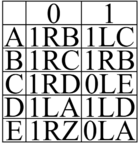5-state busy beaver winner
The 5-state busy beaver winner is the Turing machine whose step count determines BB(5). Up to permutations, that machine is 1RB1LC_1RC1RB_1RD0LE_1LA1LD_1RZ0LA (bbch), which halts after 47176870 steps with 4098 ones on the tape.
Description

This machine essentially creates an integer variable starting at 0 and repeatedly applies a linear function to it whose leading coefficient is , ending when the variable is found to be congruent to 2 modulo 3.
Attributions
This machine and its step count were first reported on by Heiner Marxen and Jürgen Buntrock in February 1990[1]. The high-level rules were first demonstrated by Michael Buro in November 1990[2].
Analysis
Let . Then[3],
Consider the configuration . After one step this configuration becomes . We note the following shift rule: Using this shift rule, we get after steps. If , then we get four steps later. Another shift rule is needed here: In this instance, is substituted for , which creates three different scenarios depending on the value of modulo 3. They are as follows:
- If , then in steps we arrive at , which is the same configuration as .
- If , then in steps we arrive at , which in five steps becomes , equal to .
- If , then in steps we arrive at , which in three steps halts with the configuration , for a total of steps from .
Returning to , if , then in three steps it changes into . Here we can make use of one more shift rule: Doing so takes us to in steps, which after one step becomes the configuration , equal to . To summarize: We have . As a result, if , we then get and the above rule is applied until we reach , equal to , in steps for a total of steps from (with we see the impossible configuration , but it reaches in 15 steps regardless). However, if , we then get which reaches , equal to , in steps ( steps total).
The information above can be summarized as[4]
Substituting , , and to each of these cases respectively gives us our final result.
Trajectory
The initial blank tape represents , and the Collatz-like rules are iterated 15 times before halting:

References
- ↑ H. Marxen and J. Buntrock. Attacking the Busy Beaver 5. Bulletin of the EATCS, 40, pages 247-251, February 1990. https://turbotm.de/~heiner/BB/mabu90.html
- ↑ Buro, Michael (November 1990). "Ein Beitrag zur Bestimmung von Rados oder Wie fängt man fleißige Biber?" [A contribution to the determination of Rado's - or - How to catch busy beavers?]. Schriften zur Informatik und angewandten Mathematik (Report No. 146). Rheinisch-Westfälische Technische Hochschule Aachen. https://skatgame.net/mburo/ps/diploma.pdf
- ↑ Pascal Michel. Behavior of busy beavers. https://bbchallenge.org/~pascal.michel/beh#tm52a
- ↑ Aaronson, S. (2020). The Busy Beaver Frontier. Page 10-11. https://www.scottaaronson.com/papers/bb.pdf